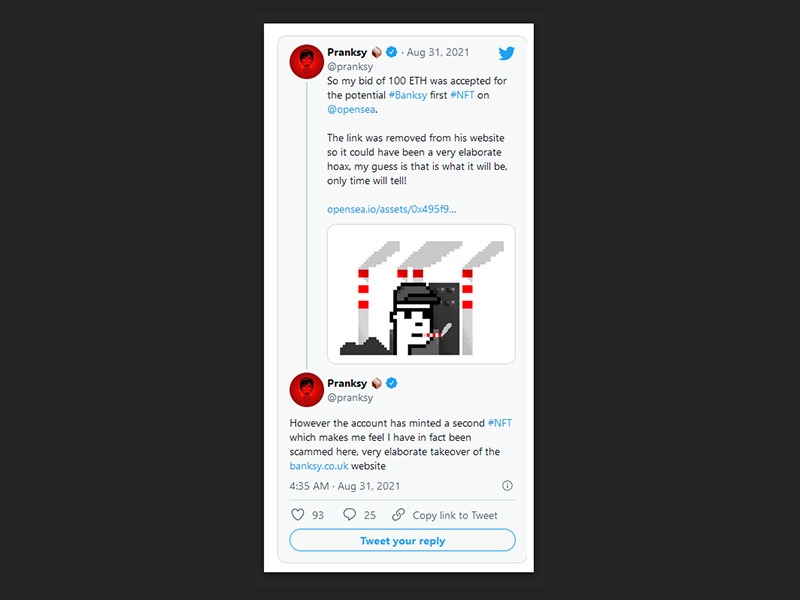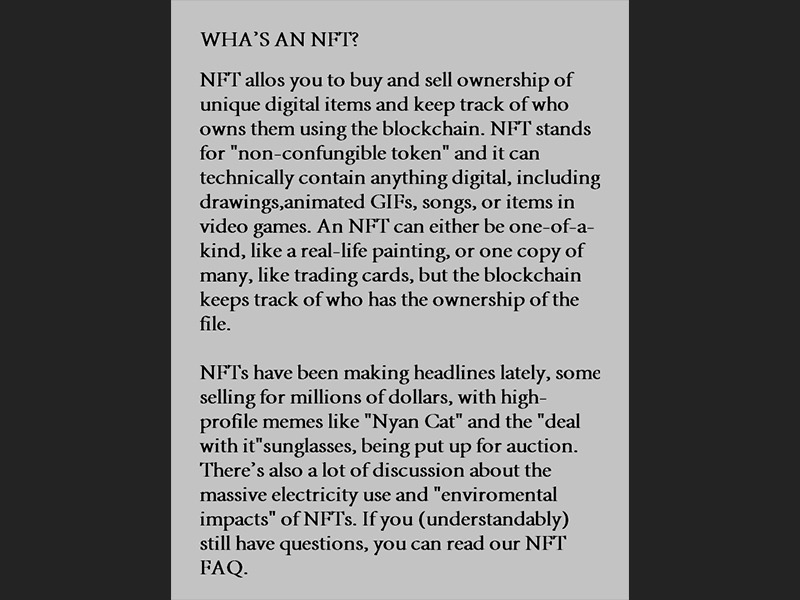Pranksy, the scammers building on a scam, and the refund
The NFT space continues to be weird and occasionally wonderful, but today’s story is going for some sort of award: a collector paid over $300,000 in Ethereum for an NFT from someone claiming to be Banksy after the image appeared on the famed street artist’s website. Then, Banksy’s spokesperson said that the artist had no involvement with NFTs, and stories came out declaring it a fake. Finally, the NFT’s seller spontaneously refunded the collector, seemingly with no note. Oh, and to really muddy the waters, the collector who bought the NFT goes by the name of Pranksy.
Pranksy told the BBC that he heard about the auction, which was being held on the NFT marketplace OpenSea, from someone in his Discord. (The BBC doesn’t identify Pranksy by name, but he has since revealed that he purchased the NFT, which is verifiable on his OpenSea page.) It seemed legit, as the seller had posted a link to a page on Banksy’s official website, at https://banksy.co.uk/nft.html, which the Wayback Machine confirms existed. The page showed a picture of the NFT being sold, which depicts a Cryptopunk-esque person smoking in front of industrial smokestacks.

Less than an hour later, the seller accepted Pranksy’s bid for over $300K, which made him suspect it was a scam. That suspicion wasn’t helped by the NFT page being deleted from Banksy’s website. Then, the artist’s spokesperson told the BBC that there weren’t any NFT actions associated with Banksy
and that the artist hadn’t “created any NFT artworks.” At that point, Pransky more or less accepted that he’d been scammed. He wasn’t the first. We’ve seen sellers try to pass off other artists’ work as their own before, and if this situation involved pretty much any other artist, there likely wouldn’t be any question if this was a scam — especially given the weirdness happening with duplicates. Pranksy told The Verge that another scammer had created a duplicate NFT, then gifted it to him. The other person used a similar username to the original seller, minted a few other NFTs in the same style, then sent one to Pranksy. Since then, a torrent of other fakers popped up, minting the same images as NFTs, sending some to Pransky, and listing the other ones for sale. It probably goes without saying that nobody should buy them.

With Banksy, though, there’s always some level of doubt as to what is or isn’t the artist’s work. This is the same person who says he tried to build a painting that shredded itself and who reportedly had his quote saying “copyright is for losers” thrown back at him during a trademark battle. What’s irony, what’s real, and what’s not is usually at least somewhat up in the air with him. While his team’s denials seem very clear cut, they haven’t gotten back to The Verge or the BBC about how the link for the NFT verifiably ended up on Banksy’s website.
That note was supposed to be the end of the story, but then Pranksy DM’d me to say that the original scammer had returned the Ethereum Pranksy paid for the NFT. Sure enough, the transaction between the two wallets showed up on Etherscan. Unlike the hacker who stole and then returned the Poly Network funds, whoever it was behind this didn’t leave any notes when sending the Ethereum back, making it difficult to tell what their motives were. Pranksy told me that he hadn’t been in contact with the scammer, apart from adding the person who had originally dropped the link in his Discord and following them on Twitter.

That note was supposed to be the end of the story, but then Pranksy DM’d me to say that the original scammer had returned the Ethereum Pranksy paid for the NFT. Sure enough, the transaction between the two wallets showed up on Etherscan. Unlike the hacker who stole and then returned the Poly Network funds, whoever it was behind this didn’t leave any notes when sending the Ethereum back, making it difficult to tell what their motives were. Pranksy told me that he hadn’t been in contact with the scammer, apart from adding the person who had originally dropped the link in his Discord and following them on Twitter.
So, what have we learned today? For starters, it seems clear that NFT scams are still alive and well, as the digital tokens keep attracting high-paying buyers. We’ve also gotten a look at how hard things can be to verify in the Internet age — one NFT showing up on Banksy’s website seems like proof that it’s real, but everything else points to it being a fake. Even now, it’s hard to tell whether we’ll ever know who was actually behind this whole fiasco and what they were hoping to accomplish. It really could be anybody.
Mitchell Clark | Contributed
Find your latest news here at the Hemet & San Jacinto Chronicle


























